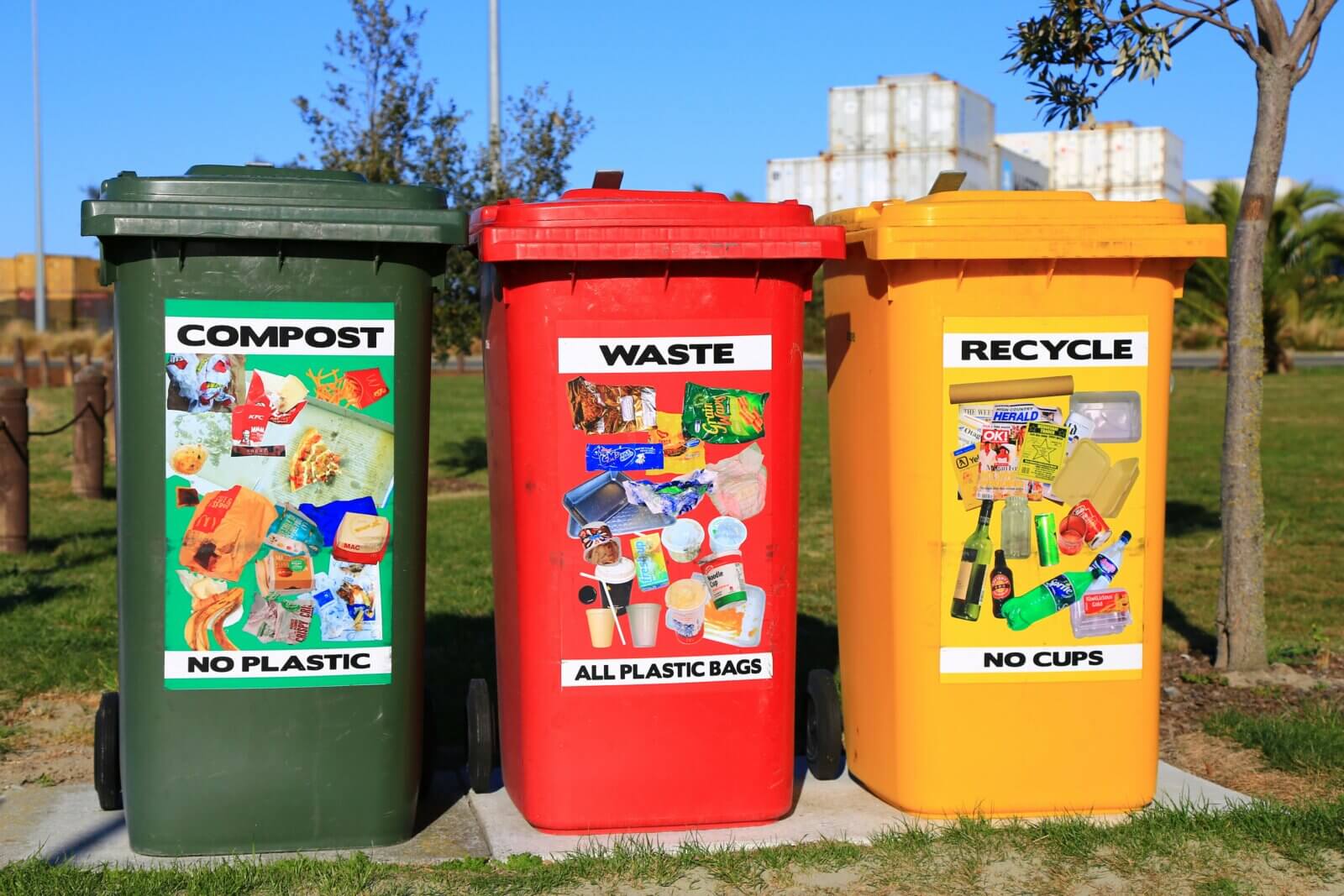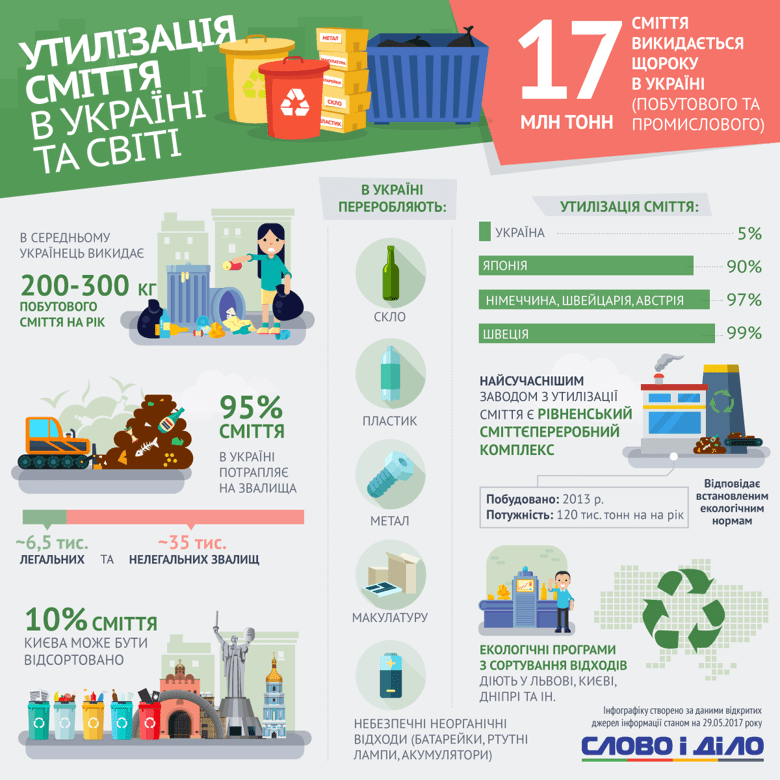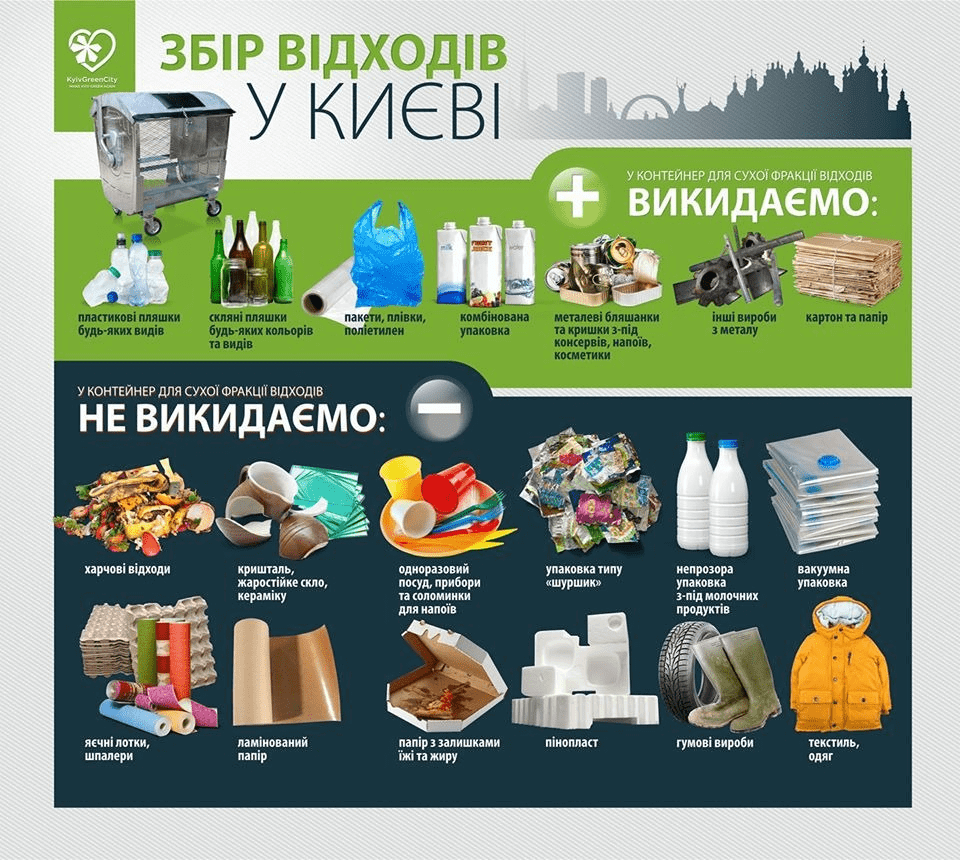
Waste sorting in Ukraine: how it works and whether it works at all
Almost every yard in the residential area has garbage cans for separate waste collection: separate for food waste, glass, plastic, and paper. Conscientious residents patiently separate the garbage, while those who are not so conscientious collect everything in one bag, shove it into any bin and say with knowledge: "They'll put it all in the same pile later anyway." Which of them is right and [...]
Content:
Almost every yard in the residential area has garbage cans for separate waste collection: separate for food waste, glass, plastic, and paper. Conscientious residents patiently separate the garbage, while those who are not so conscientious collect everything in one bag, shove it into any bin and say with knowledge: "They'll put it all in one pile later anyway." Who is right and is there any sorting of waste in Ukraine at all?
Law on waste sorting in Ukraine
From 1 January 2018, in accordance with the Law of Ukraine "About waste"According to the law, Ukrainians must sort their waste and dispose of it in appropriate bins. In the same year, it was decided to get rid of garbage chutes in multi-storey residential buildings and made changes to the State Building Code: they were cancelled as a mandatory design feature in new construction and reconstruction.
The laws and new bins should help reduce the amount of waste thrown away annually from 95% (2016) to 30% (2030) in 14 years. By 2018, it was possible to reduce the volume by only 1.2%.
According to the Ministry of Ecology and Natural Resources, Ukraine generates 17 million tonnes of household and industrial waste annually. Of this, only 5% is sorted and another 1% is incinerated at the Energia plant in Kyiv. The rest of the waste ends up at legal and illegal landfills, of which there are tens of thousands in our country.

Why is this happening? After all, if there is a law and special containers, maybe our country lacks special plants where this waste is processed and incinerated? Let's look into it further.
What waste incineration and recycling plants are there in Ukraine
Until 2014, there were five waste incineration plants in Ukraine: in Dnipro, Kyiv, Rivne, Sevastopol, and Kharkiv. By 2020, only the Energia plant in Kyiv will be in operation, which not only burns waste but also provides heat to residential buildings.
For some time, the Energia plant was closed for major repairs, but in early 2019 it was reopened. In the video, you can see how it looks and what has been improved.
The waste incineration plant in Rivne was built in 2013 and operated for only 6 months. Now it is also operating, but as a waste recycling facility that processes up to 120,000 tonnes of waste per year.
There are 22 sorting lines in Ukraine that sort household waste. These lines separate cardboard, plastic bottles, iron and glass cans from the total volume of waste and send them for recycling.
Other companies are involved in the processing of industrial waste. There are about 28in Kyiv and Kyiv region, Odesa, Poltava, Zaporizhzhia, Lviv, Bila Tserkva, Mykolaiv and other cities. These companies are engaged in the disposal of hazardous construction waste, recycling of used batteries and oils, recycling of documents, and food disposal. Some of them extract electricity from waste.
The largest in Ukraine is to be built in Zhytomyr by 2022 solid waste processing plant. The contractor is the Croatian company Tehnix, which has already invested more than €10 million in the construction. When it is built and launched, the city's landfill (which has been operating since 1957 and is heavily overloaded) will finally be closed.
How waste is sorted and recycled
Laws, containers, special machines, people and businesses - everything is in place and everything is functioning. Albeit not in every locality. But at the same time, landfills are still flourishing and occupying more and more areas.
The main problem is that people do not yet have a clear understanding of what wet fractions and dry fractions are. These are two types of waste that cannot be mixed together, otherwise the entire mass of dry fractions is considered contaminated with biological particles and cannot be recycled.
In big cities, there are brand-new containers: shiny, clean, and some even have smart electronic filling panels powered by solar panels. They have detailed information on what can and cannot be thrown away, but people still continue to throw tetra-packs and plastic bottles into the glass bin and cardboard and packaging into the plastic bins. A container with such mixed waste cannot be taken to the plant immediately, as it will first have to separate the dry fractions from the wet. This is an additional waste of time and resources.
Examples of this attitude can be found in every city in Ukraine. Take the small town of Vyshgorod, 20 km from Kyiv. A separate waste collection project has been running there for two years, but people still continue to throw rubbish in the same pile . If you throw bottles into the glass bin in Vyshhorod, get ready to hear the soft rustling of garbage bags with food waste rather than the clatter and ringing.
To be recycled, recyclable materials must be clean. To do this, it must not be mixed with food waste. Remember that in our country, sorting is not done by machines, but by people: they manually sort the shipped waste in not the best conditions. To make their work easier, sort your waste carefully, rinse bottles before handing them in, and bags and boxes of fatty food are not suitable for recycling at all and should be burned.

New waste processing plant in Zhytomyr promise to make it more modern and closer to European enterprises in terms of technological equipment. They are going to automate waste sorting as much as possible, so that it can be carried out with minimal human intervention.
There are other types of waste that should not be disposed of in ordinary containers at all. These include batteries and accumulators, chemicals, machine oil, lamps containing mercury, and so on. These are collected and disposed of by special companies.
There is a special card "Where to dispose of waste"Enter the city and see on the map where the collection points for batteries, aluminium cans, thermometers, etc. are located.
A question for everyone: to sort or not to sort
With many eco-projects for waste collection and sorting being recognised as unworkable even in Europe, Ukrainians are not so enthusiastic about sorting their waste. But if everyone takes part in solving the problem, it will bring results:
- Separating organic matter from dry raw materials to be recycled will help reduce the number of landfills and enable existing landfills to recover faster (food waste decomposes in a month);
- Ukrainian companies will not have to buy raw materials to create new products - boxes and books will be made from recycled cardboard, and plastic will be made from plastic. This will save money and make goods cheaper;
- less waste and less environmental pollution - new products will be made from old ones.






